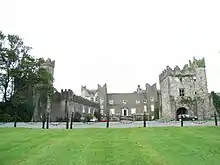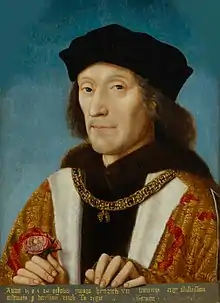Robert St Lawrence, 3rd Baron Howth
Robert St Lawrence, 3rd Baron Howth (born c.1435 – died before 1488) was a leading statesman in 15th-century Ireland who held the office of Lord Chancellor of Ireland. Through marriage he was a close connection of the Tudor dynasty.
Background
He was born about 1435, the eldest son of Christopher St Lawrence, 2nd Baron Howth.[1] There is some dispute about the identity of his mother, but she was most likely Anne Plunkett. He succeeded to the title between 1462 and 1465.[2]
Career
O'Flanagan calls him "a nobleman of considerable abilities, who filled several offices connected with the Government of Ireland." [3] He was also, like his father, determined to assert his and his family's traditional rights as Lords of Howth, and was sometimes accused of overstepping the law as a result. In 1468 he was accused of attacking a Breton merchant ship off nearby Lambay Island, pursuing it as far as Drogheda, and seizing the anchor. However he was acquitted of the charge.[4] Much later, in 1482, he had a dispute with Dublin Corporation over its right to levy customs at Howth, insisting that by long tradition this was his sole prerogative. He agreed to send the matter to arbitration, and eventually accepted that the Corporation was in the right. He himself was receiver of customs for the ports of Rush, Rogerstown and Portrane. In 1460 he was charged with overseeing the drainage work at Balrothery bog.[5]
He was an associate of the powerful and charismatic Thomas FitzGerald, 7th Earl of Desmond, whose supposed ambitions to rule Ireland aroused the suspicion and hostility of the English Crown.[6] The notoriously vindictive session of the Parliament of Ireland held at Drogheda in 1468 was entirely devoted to destroying Desmond and his associates.[7] Howth however was able to obtain an exemption from any acts of forfeiture passed by Parliament.[8]
He was High Sheriff of County Dublin in 1456, Chancellor of the Green Wax in 1468, Chancellor of the Exchequer of Ireland in 1478 and Clerk of the Court of Common Pleas (Ireland). Like his father he played a key role in the defence of Dublin. He was ordered to erect a tower at Kilmainham bridge, and in 1467 was charged with organising the militia. In 1474 he was chosen to be one of the thirteen Knights of the Brotherhood of Saint George, who were charged with defending the Pale against invasion by neighbouring Gaelic clans, and with keeping the peace generally.[9]

In 1483 Richard III chose him to be Lord Chancellor of Ireland, despite opposition from Gerald FitzGerald, 8th Earl of Kildare, who was then almost all-powerful in Ireland. His continued employment by the Yorkist kings after his second marriage in 1478 is surprising, given that his second wife Joan Beaufort was a close relative of Henry Tudor, who was to overthrow the House of York in 1485. In any event his tenure as Lord Chancellor was short, ending either with his removal or his death. His death probably took place later in 1483, although some sources place it as late as 1487.[10]
Family
Robert married firstly Alice White, daughter of Nicholas White of Killester, and by this marriage acquired the manor of Killester.[11]In 1478 he made a second and politically significant marriage to Joan Beaufort, daughter of Edmund Beaufort, 2nd Duke of Somerset and Eleanor Beauchamp. Somerset's seemingly remote claim to the English Crown as the legal heir of John of Gaunt was inherited by his cousin Margaret Beaufort's son Henry VII, who became first Tudor monarch. The St Lawrences, unlike most of the Anglo-Irish nobility, were reliable supporters of the Tudor dynasty: clearly the family connection was too valuable to them not to be taken full advantage of.

He had six children:
- Nicholas St Lawrence, 4th Baron Howth
- Thomas St. Lawrence, who became Attorney General for Ireland and a judge of the Court of King's Bench (Ireland)[12]
- Walter
- Christopher
- Genet, who married Thomas Fitzsimons
- Anne, who married William Golding.
Some sources state that his second marriage was childless, however his eldest son Nicholas, who was born about 1460, must have been about twenty years older than his second son Thomas, who was studying law at the Inns of Court in London in 1503 and survived until 1553, so it is likely that Thomas, Walter and Christopher were children of their father's second marriage to Joan Beaufort. Joan remarried Sir Richard Fry and died in 1518.
References
- McCormack, Anthony M. "Robert St Lawrence, 2and Baron Howth" Dictionary of Irish Biography Cambridge University Press
- McCormack Dictionary of Irish Biography
- O'Flanagan, J. Roderick. Lives of the Lord Chancellors and Keepers of the Great Seal of Ireland 2 Volumes London 1870
- McCormack Dictionary of Irish Biography
- McCormack
- Ross, Charles Edward IV Eyre and Methuen 1974 p.204
- Otway-Ruthven, A. J. A History of Medieval Ireland Barnes and Noble reprint New York 1993 p.392
- McCormack
- McCormack
- Ball, F. Elrington The Judges in Ireland 1221-1921 John Murray London 1926
- McCormack
- Burkes Peerage
| Peerage of Ireland | ||
|---|---|---|
| Preceded by Christopher St Lawrence |
Baron Howth 1462–c.1488 |
Succeeded by Nicholas St Lawrence |
